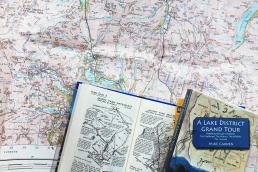
Over the Easter weekend, my wife and I finally decided to embark on our adventure up England’s well-known national parks, Lake District. I had spent weeks researching the different hikes, fells, lakes and valleys that would satisfy my yearning for the outdoors. But really, what can one do in a few days, in a landscape that demands at least years of exploration?
Almost half a day’s drive later, we arrived in Ambleside, one of the Lakes’ picturesque towns that serve as a starting point for exciting hikes and walks around in the area. For this trip, we decided on Cathedral Quarry.
Cathedral Quarry and its hidden cave was something of a whisper in these parts. It’s only in recent years, and the advent of hiking forums and travel sites did these mummers grow louder. There’s a scattering of guides on how to access this hidden cave on a Google search. Thankfully, it’s not commercialized (yet) but in the far future, Cathedral Quarry may very well turn into one of Ambleside’s drawing points.


We began our journey walking across the plains, crossing into a farm area and eventually ending up nearby a mossy forest. We took a turn around the river bend until we met another hiking couple that kindly informed us that Cathedral Quarry was in the opposite direction. We turned around the hill, keeping an eye out for possible entry points to this elusive cave.
It wasn’t until we were walking alongside River Brathay did I notice a group of hikers coming down from the hillside.
“You looking for the cave up here, mate?”
“Yes – Cathedral Cave?”
“That’s the one. Lovely, really beautiful! Climb up here, walk along the ridge and you’ll eventually see the entrance. You have to see it.”
I didn’t need any more convincing. We climbed up the pebble stairs and a wisp of shower coated the ground we walked on. The forecast during Easter was not kind to the outdoors, but I was determined to at least see this cave.

It should be noted that historically (since the 16th century), the slate quarries and copper mines around the area provided additional income to the surrounding local farms, who leased the quarries to companies. There are many uses of green slate, many which are for tiling purposes – the prime examples being the long walls that run throughout Britain’s countryside.
Cathedral Cave, a name taken from the large Cathedral-like chamber and its sun-lit ‘window’ was just a tunnel away.
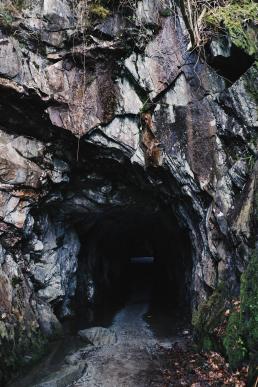
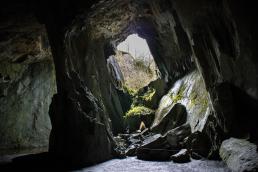
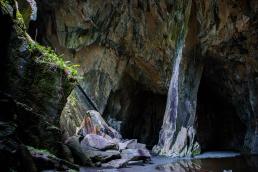
I’ve been in a few caves over the years and every time, I’m always amazed by how ancient and primordial the sense of being in one gives. Cathedral Cave was no exception. With the single slate blade holding up the ceiling, and the pool surrounding a corner of the chamber – there is a sense of being a part of something older than civilization.
The jagged ceiling and cave walls tells stories beyond the hundred years of mining. Its natural spectrum of indigo, rust, chalk and emerald crossing each other’s narratives.
In the opposite end of the chamber was a small tunnel leading out to a steep climb leading to a landing that’ll allow you to peek into the cavern from the sunlight opening. It was already drizzling, wet and the slippery slate rocks would have been too dangerous an attempt for both of us – so we got back into the cave and passed through the same way we got in.
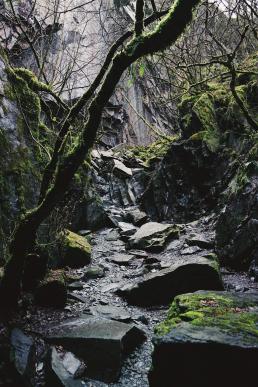

By the time we descended from the hill, rain was already on the way, so we hurried across the plains and sought refuge from The Three Shires Inn, where we spent the remainder of the afternoon enjoying hot chocolate and the warmth of the cottage inn’s pub. We weren’t the only one, being among the many other hikers who themselves had come in for ciders and lagers to warm themselves up after a morning in the outdoors.

Recommended Reading:
- Cathedral Cave – Visit Cumbria
- Hodge Close Walk – National Trust
- Waterfalls and the Cathedral Cavern – WalkLakes
- The Magic of Cathedral Quarry – David Clapp